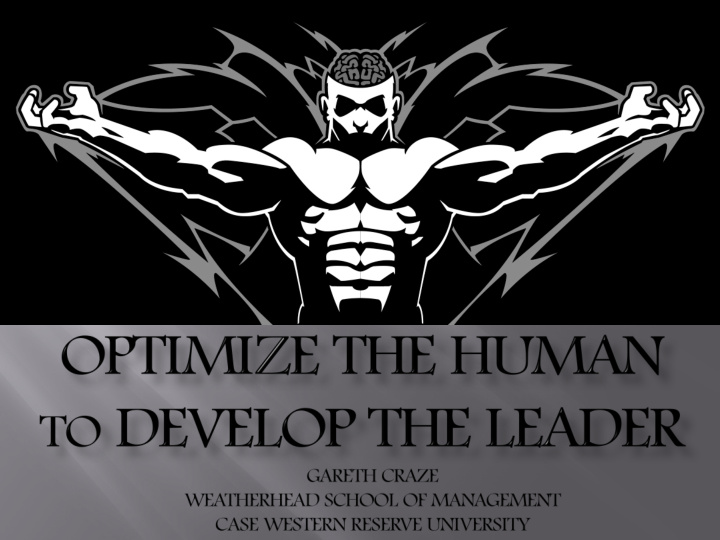



¨ Evolutionary mismatch: “when the environment that organisms are adapted to, via a slow process of biological evolution, changes so quickly and intensely that it hinders these organisms.” (Van Vugt, 2018) ¨ Archetypal business environments, especially those in developed economies, are about as far removed from an evolutionarily adapted state of nature as humans could possibly inhabit.
¨ As one’s seniority (and associated level of responsibility) increase, so too does one’s likelihood of experiencing debilitating stress, depression and anxiety (Barling & Cloutier, 2017). ¨ The effects of emotional contagion (whereby emotional states can be transferred across people) are more severely pronounced in leader-follower relationships (Barsade, 2002). ¨ Executive coaching and development practices – which emphasize developing emotional competencies – are widespread. So why does poor emotional health continue to endure for leaders?
¨ Strong emphasis in leadership development on one’s vision (their ‘Ideal Self’) and values (Boyatzis, 2006). Bringing out their best as people. ¨ Coaching for intentional development. ¡ Engaging mindfulness, hope and compassion. ¡ Coaching with compassion vs. coaching for compliance. ¨ Teleological approach to leadership development. ¡ Discovering one’s purpose to reach their potential. ¨ These are the things that matter! ¡ When leaders can embrace their sense of purpose and pursue their vision, their organizations are better positioned to thrive.
¨ The ability to craft and pursue a vision, and lead with a sense of purpose, is contingent on possessing strong emotional competencies (Boyatzis, 2011). ¨ Emotional competencies are contingent on strong emotional health (Ciarocci et al., 2003). ¨ Emotional health is contingent on strong psychophysiological health (Tsirigotis & Ł uczak, 2015). ¨ The evolutionary mismatch of modern business life is wreaking havoc with the psychophysiological health (and thus the emotional health and competencies) of leaders.
¨ 15% of all occupations in the US have been classified as wholly sedentary, with another 70% only demanding light-medium physical exertion. ¨ Physical inactivity during the day is one of the strongest predictors of a sedentary lifestyle in general (Ekelund et al., 2016) ¨ 90 seconds of walking every 30 minutes significantly reduces several inflammatory biomarkers (Peddie et al., 2013)
¨ The workplace tends to be where people consume most of their sugar intake (Bleich et al., 2008). ¨ Sugar consumption promotes stress; stress promotes sugar consumption (Tryon et al., 2015). ¨ Sugar consumption promotes fatigue; fatigue promotes sugar consumption (Cao et al., 2016). ¨ Sugar consumption promotes low mood; low mood promotes sugar consumption (Benton, 2002). ¨ Emotional contagion can turn organizations into vectors for the transmission of stress, fatigue and low mood (Barsade, 2002).
¨ We are stuck in offices all day away from the sun, before being shrouded in artificial lighting at night. ¨ Both lack of exposure to sunlight and sustained exposure to artificial lighting are associated with reductions in positive affect and employee mood in the workplace (An et al., 2016). ¨ We are all but completely protected from the elements and spend our days in an artificial “Goldilocks” climate with central office heating and air conditioning at our beck and call. Similar consequences for positive affect and employee mood in the workplace (Christopolous, 2016)
¨ Stress: “the health epidemic of the 21st century” (World Health Organization, 2015) ¨ Costs US businesses $300 billion per year in reduced productivity and increases in absenteeism/turnover. ¨ We evolved under conditions of great stress, and some amount of stress is beneficial (‘eustress’; Le Fevre, 2003). ¨ BUT the kinds of acute, primarily socially-induced stressors encountered by most people in organizational life are associated with a range of negative individual and organizational-level outcomes (Boyd et al., 2009) ¨ Compare with ‘struggle’ (Lilius et al., 2002).
¨ Long working hours (> 48 hours per week; Kodz et al., 2003) result in commensurate decreases in restful sleep. ¨ People are increasingly dragging work home with them, impacting on both sleep itself and the quality of relaxation in prior hours. ¨ ‘The Sleepless Elite’: upper-level executives (in particular) are prone to burning the candle at both ends, resulting in downstream deleterious effects on their organizations (Chee, 2013).
¨ Current leadership development frameworks might be emphasizing the potential of people while failing to recognize the constraints of humans. ¨ Things like diet, physical fitness etc. are widely seen as a private matter with private consequences. ¨ Stress, fatigue, variable mood and emotional regulation are viewed as “part of the leadership package.” ¡ An unsustainable and unhealthy emphasis on “career first.” ¡ “Figure out your personal health on your own time.” ¨ The line between ‘life’ and ‘work’ has become increasingly blurred.
¨ An evolutionary framework allows us to recognize how much humans – as closed physical systems with constraints – need to be optimized before we can properly develop people (and, in turn, leaders). ¨ We already develop policies and practices based on this recognition all the time (however unknowingly): ¡ Coaching with compassion vs. coaching for compliance ¡ Employee wellness initiatives ¡ Corporate ‘hacks’ ¨ Evolutionary theory helps to explain why and not just that .
Qu Questions and and com comments ki kindly ap appreciat ated. Gareth Craze, Weatherhead School of Management, Case Western Reserve University gareth.c .craze@case se.e .edu
Recommend
More recommend